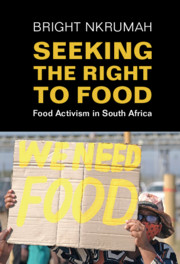Book contents
- Seeking the Right to Food
- Seeking the Right to Food
- Copyright page
- Epigraph
- Dedication
- Contents
- Tables
- Abbreviations and Acronyms
- Additional material
- Preface
- Acknowledgements
- 1 Food Activism and Policy in South Africa
- 2 A Tale of Food Activism
- 3 The Case of Right to Food Campaign
- 4 Rocking the Boat? Mobilising for Food Security in South Africa
- 5 Food (In)Security and Legal Implications in South Africa
- 6 The Unfinished Agenda: Perspectives on South Africa’s Food (In)Security
- 7 Dispossession: Reforming Land in South Africa
- 8 Ethical Obligation to Assist Impoverished South Africans
- 9 What Is to Be Done: Overcoming Policy Fragmentation in South Africa
- References
- Index
- References
References
Published online by Cambridge University Press: 06 August 2021
- Seeking the Right to Food
- Seeking the Right to Food
- Copyright page
- Epigraph
- Dedication
- Contents
- Tables
- Abbreviations and Acronyms
- Additional material
- Preface
- Acknowledgements
- 1 Food Activism and Policy in South Africa
- 2 A Tale of Food Activism
- 3 The Case of Right to Food Campaign
- 4 Rocking the Boat? Mobilising for Food Security in South Africa
- 5 Food (In)Security and Legal Implications in South Africa
- 6 The Unfinished Agenda: Perspectives on South Africa’s Food (In)Security
- 7 Dispossession: Reforming Land in South Africa
- 8 Ethical Obligation to Assist Impoverished South Africans
- 9 What Is to Be Done: Overcoming Policy Fragmentation in South Africa
- References
- Index
- References
Summary
- Type
- Chapter
- Information
- Seeking the Right to FoodFood Activism in South Africa, pp. 184 - 218Publisher: Cambridge University PressPrint publication year: 2021
- Creative Commons
- This content is Open Access and distributed under the terms of the Creative Commons Attribution licence CC-BY-NC 4.0 https://creativecommons.org/cclicenses/

